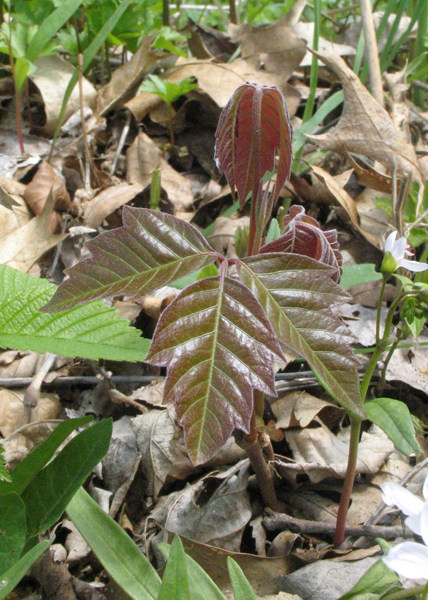
Date: May 6, 2008. Location: Kent Park(map)
| Classification Hierarchy | |
| Kingdom | Plantae |
| Subkingdom | Tracheophyta |
| Superdivision | Spermatophyta |
| Division | Magnoliophyta |
| Class | Magnoliopsida |
| Subclass | Rosidae |
| Order | Sapindales |
| Class | Anacardiaceae |
| Genus | Toxicodendron |
| Species | Toxicodendron radicans |

Date: May 6, 2008. Location: Kent Park(map)
Scientific Name: Toxicodendron radicans ([L] toxicodendron = poison tree; radicans = root - a reference to the aerial roots on the vining stems) Synonyms: Rhus radicans, Rhus toxicodendron .
Common Name: Poison Ivy
Origin: Native (L48)
Notes: Poison Ivy—in shrub or vine form— is common in disturbed places,
roadsides, and wooded areas—some authors treat the shrubs as one species
[ Toxicodendron rydbergii ]
and the vining plants as a separate species [T. radicans]. It's best known
structure are the "leaflets three" which in spring and autumn display a reddish tint. During the summer growing
season they are green. This species is sometimes confused this Virginia creeper
(Parthenocissus quinquefolia)
which has a similar vining growth habit.
Additional references: 1, 2,
3,
4,
5,
6,
7,
8,
9.
Flowers: May, inflorescence is a panicle of yellow to
whitish-green five petaled flowers. Fruit: at maturity, a buff
colored, subglobose, drupe with an outer brittle epicarp (exocarp), a tough mesocarp, and a thick inner endocarp.
Stems: woody and persistant; vining stems with aerial roots.
Leaves: alternate with petioles 2 to 10 cm long, with 3 leaflets; the terminal leaflet longer stalked than the two laterals.
Glossaries of botanical terms: 1,
2,
3,
4,
5,
6,
7.
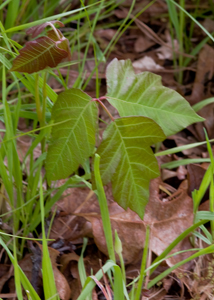
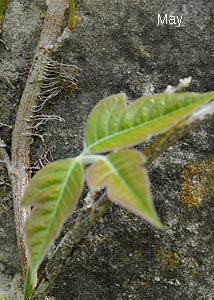
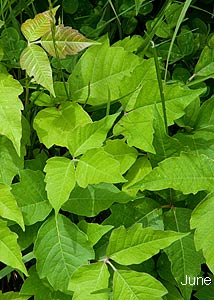

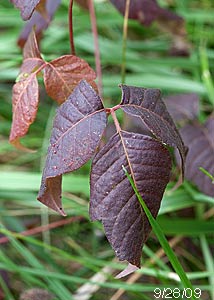

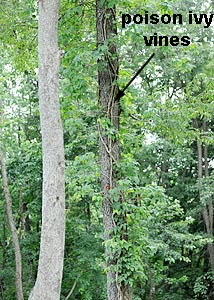
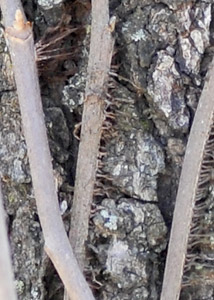
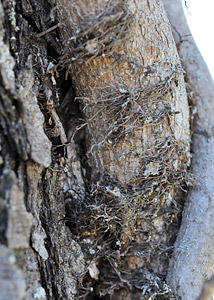
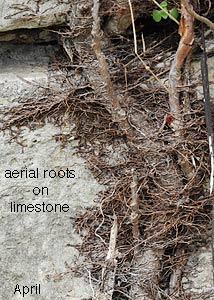
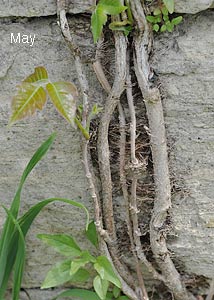

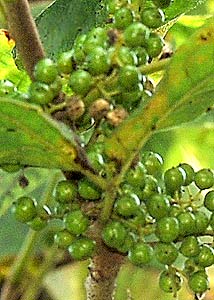
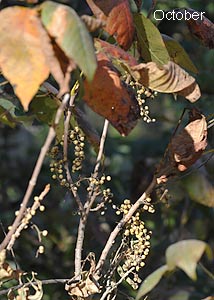


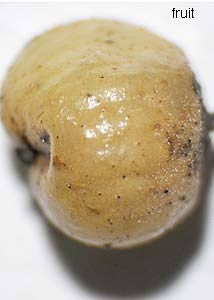
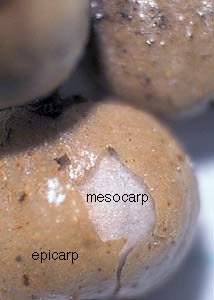

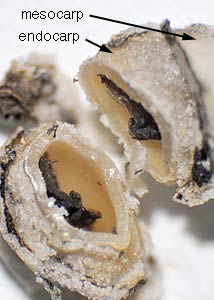
Comments: Poison Ivy (and several other members of the family Anacardiaceae) produce Urushiol (pronounced oo-RU-shē-ol)
which is a collection of several similar molecules–lipophilic catechols (dihydroxyphenols). It is their lipophilic feature that allows them to dissolve in skin oils.
Urushiol is produced by specialized cells in the phloem and found in the waxy cuticle of leaves and in the sap
transported through the phloem tissues—partiularly in resin ducts located in the phloem. The Wayne's word web site
offers a good explanation on the reaction of human skin to contact with poison ivy. Scroll down to heading 5 to see the location of the resin ducts.
In a related plant T. vernicifluum (Japanese lacquer tree). The sap is under positive pressure and when any part of the plant
is damaged the sap exudes from the wound. When the yellowish sap is exposed to air it turns black as the urushiol becomes oxidized. It is in the oxidized
state that urushiol becomes an active irritant to human skin.
Understanding how urushinol causes an allergic response in the skin might benefit from a review of the relevant chemistry, skin histology, and immuno chemistry.
Recall that benzene is a six carbon ring, phenol is a benzene ring substituted with a hydroxyl group (-OH), a catechol is phenol substituted with another
hydroxyl group in the ortho position, urushiol is a substituted catechol with a string of molecules attached to the benzene ring at the carbon adjacent to
the second hydroxyl group. The carbon string is designated with the letter R.